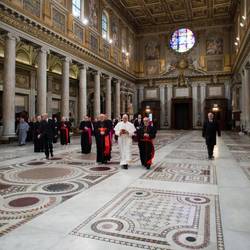Operation Saint Mary Major
By Giacomo Galeazzi
Saint Ignatius of Loyola celebrated his first mass here, on Christmas night in 1538. A stop at Saint Mary Major has always been a must during the Jesuit Bergoglio's travels to the eternal city. Deeply devoted to the patroness of Rome (the Salus Populi Romani), he began his pontificate from the basilica which houses a relic of the Manger in Bethlehem and Bernini's tomb. "He is very fond of this church, he came often as a cardinal," says Fr. Elio Monteleone, one of the confessors in the West’s oldest Marian Sanctuary. Yesterday morning, the newly elected Pope said to confessors: "Souls need you to be merciful; pray for me." A Marian Pope like Wojtyla, who consecrated his pontificate to the Virgin Mary (Totus tuus), Francis, who had just appeared in Saint Peter's dressed in white, announced the first appointment in his calendar: prayer to Mary. Tradition has it that it was the Virgin Mary herself who inspired the construction of her residence on the Esquiline Hill. Arriving shortly after 8:00 AM, the Pope was accompanied by the archpriest and former Nuncio in Latin America, Santos Abril y Castello, and by Cardinal Vicar Agostino Vallini. He was welcomed by the chapter of the basilica, the priests, the lay employees, Archpriest Emeritus Bernard Law and the prefect of the Pontifical Household, Georg Gaenswein. It is one of the four patriarchal Basilicas of Rome and it is the only one that has retained its Paleo-Christian structures, but in the last days before the Conclave, in addition to tourists, the impressive temple had been crowded by a plurality of "prospects" for the future of the papacy. Compared to 2005, Saint Mary Major has seen its importance in the Papal election change radically. Eight years ago the Law scandal was burning hot: the Archpriest was accused of covering up cases of sex abuse by priests when he was the leader of the Archdiocese of Boston. This time, on the other hand, the "master of the house" was the refined diplomat who, at the eleventh hour, was able to play the card of understanding between Rome and South-America, which turned out to be the winning card. And so, Bertone-supporter Santos Abril y Castello treasured the long years spent in contact with the "latino" episcopacies where the desire to produce a Pope for the first time in history was growing. Despite the fact that they hold the "majority of shares" in the universal Church (by number of believers), once again the South Americans seemed destined to succumb in front of the candidacy of the Italian non-Curia member, Scola. However, at this point a convergence of reasons, strategic designs and geopolitical scenarios came into action. The Archpriest of Saint Mary Major glimpsed a chance for an eleventh- hour pact between the non-Europeans and the curials who were opposed to a cardinal so close to Communion and Liberation. Representatives from the United States, Sodanians and Bertonians: the majority that crowned Bergoglio was created bit by bit. "Like the tiles of a mosaic", says a former Vatican head of a dicastery. A canvas of consensus that, at the end, is even wider than expected. The expansive force of South American Catholicism became the glue for the scattered votes of the first black smoke episodes. Both the "stars and stripes" conclavists and the Holy See's Ministers who receive the dossier from nunciatures and from the Bishops' conferences are well aware of this. The contraction of Christianity in Europe and more generally in the West is compensated by the new Latin American Christianity, which is not only Pentecostal or Evangelical but also Catholic. Outside Latin America, the nation that derives the most advantages from "Latin" vitality is the United States. A survey conducted by the Pew Forum on Religion reveals that between now and 2030 the number of South American Catholics in the USA will jump from 33% to 41%. Among U.S. Catholics over 60 the vast majority are white, but among those aged between 18 and 40 almost half came from Mexico and other countries of the continent. These are the only new recruits able to compensate for the abandonment of the Catholic Church by young whites under the age of 30, the age group most eroded by secularism.
|
.
Any original material on these pages is copyright © BishopAccountability.org 2004. Reproduce freely with attribution.
